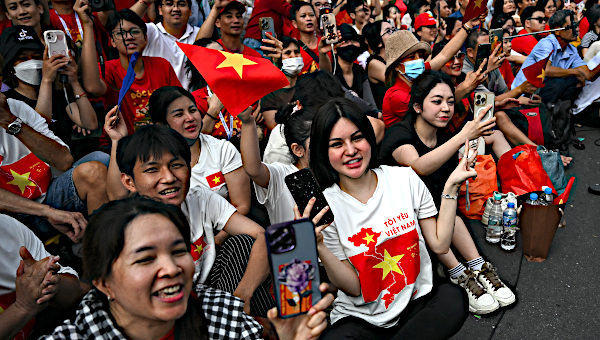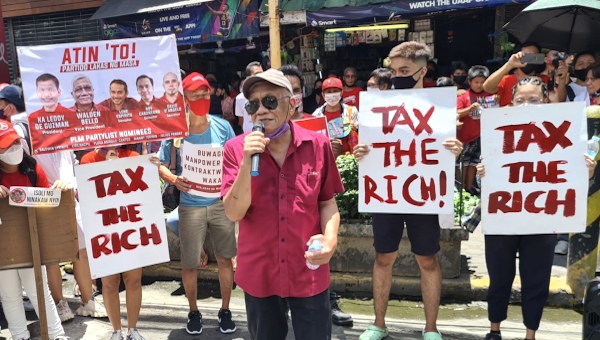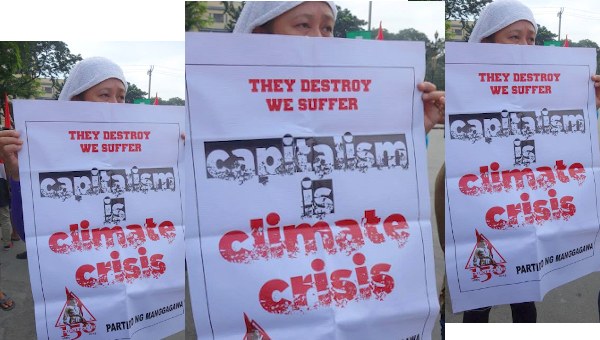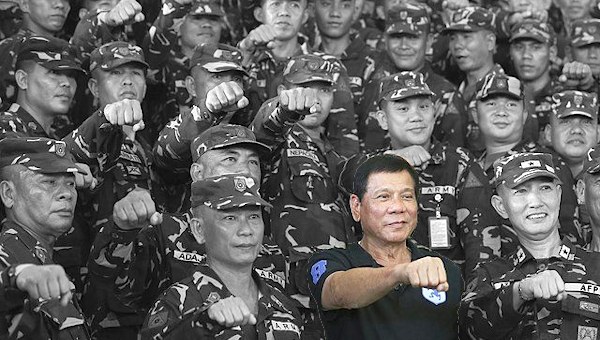Hardships and Authoritarianism: Understanding Politics in the Philippines
On Sunday March 7, nine human rights activists were killed and six others arrested in coordinated police and military actions in the Philippines. This was an escalation of the state repression and targeted assassinations that have become a common occurrence under the regime of President Rodrigo Duterte since his election in 2016 under the rubric of a ‘war on drugs’. Bloody Sunday is another incident in the state violence deployed by Duterte’s regime. But the state violence also marks a new phase in a so-called ‘whole of nation’ approach to combating the insurgency of the Communist Party of the Philippines, and the armed wing New People’s Army, with the raids and murder of unarmed political activists. Bloody Sunday represents a further closure of democratic space in an intensification of state violence, ‘national security’ measures reorganizing state apparatuses, and the erosion of fundamental human rights. The paths forward for the left in the Philippines at this moment to a mass movement able to defeat Duterte and set an alternate economic and social agenda remains unclear. The essay below provides some political perspective and historical background to these latest events.
Philippine President Rodrigo Duterte’s latest outrage is an attempt to shift the blame for rising numbers of COVID-19 cases onto healthcare workers. Duterte made his extraordinary outburst – accusing them of inciting “revolution” – after reimposing strict quarantine in many of the country’s major cities on 2 August. With more than 150,000 cases, and having overtaken Indonesia’s lead within South-East Asia, the Philippine epidemic is out of control. This is mainly due to Duterte’s flawed policies.
Coming to power as a “strongman” and populist in 2016, he promised to make some progressive changes. Yet his government increasingly is characterised by all the worst features of his predecessors. For the COVID-19 crisis, it meant a highly militarised response with draconian enforcement of lockdowns and roadblocks. Coordination with primary healthcare agencies and mass testing received little emphasis. Repression and harassment of the media also escalated. And new counter-terrorism laws further threaten civil liberties.
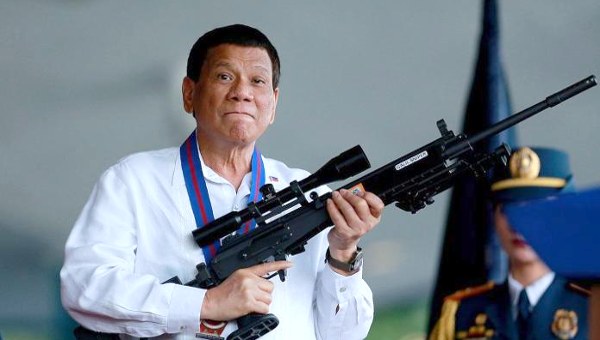
The failing healthcare system and increase in state repression both reflect the broader historical and political malaise of the Philippines. With a resident population of more than 108 million people and a per capita income of just US$3,890 (Australia’s is US$54,910), more than 20 percent of the population last year still lived below the country’s nominal threshold of poverty. In 2017, per capita health spending was just US$132.90, and the infant mortality rate was 23 per 1,000 births (compared to US$5,332 and 3.1 in Australia). There was only one hospital bed per 1,000 of the population in 2011.
Both the endemic poverty and this latest crisis are the product of historical factors that provide the context for understanding Duterte and the struggle against his government.
Colonialism and Imperialism
First is the country’s history of colonialism and ongoing relationship with the world’s imperialist powers. The archipelago’s colonisation by Spain after 1565 led to the forced conversion to Catholicism of much of the population. Church friars administered the territory, transforming favoured local chiefs into large landowners. These landowners, known as ilustrados, became a wealthy social class and a vital link in the chain of colonial domination. Political and economic power shifted toward the more densely populated and controlled region on the main island of Luzon. The Spanish retained control until the end of the nineteenth century, when a nationalist political revolt began.
Meanwhile, industrialisation and the emergence of monopoly capitalism in the United States had spurred its desire to acquire territory in the Pacific. The Spanish relinquished ownership of the Philippines in 1899 after war with the US. But Filipino nationalists wanted the US out as well, launching a liberation war for independence. Three years later, between 250,000 and one million Filipinos were dead and the US was in control. However, US administrators did not dismantle the social hierarchy that Spain had established. They ruled in conjunction with and through local elites. The hacienda system of a few large landholders endured, and US-based corporations developed widespread plantation agriculture.
Philippine capital specialised in agricultural and raw materials exports, retailing, banking and real estate. Only a minority of the elite envisaged expanding local industries and producing consumer goods or machinery. Any Philippine-owned businesses that focused on these sectors faced stiff competition from US imports with open slather access to markets. As a result, and as in most colonised regions in the world, no deep industrialisation occurred: the economy and exports remained mostly agricultural and raw materials during the stage of colonial capitalism between 1902 and 1946. Yet an urban and rural working class emerged. The population grew and migrated to cities and towns to work in the limited industry that did develop.
The big landowners and elites also benefited from the presence of the US military. It provided them with security. This military broke the centuries-long resistance to colonialism from the mostly Muslim Bangsamoro population on the country’s southern island of Mindanao. Mindanao was opened for exploitation and internal migration for Christian settlers.
Independence
A left-wing political movement, centred on the Partido Komunista ng Pilipinas (Communist Party of the Philippines, PKP), increasingly challenged the elite’s power after 1930. The Philippines became notionally independent in 1946, after a destructive period of Japanese occupation between 1941 and 1945. The elites dominated the political system, controlling the state and the main political parties. Modelled on the US system, the Philippines emerged as the first “democratic” republic in Asia. As Leon Trotsky’s concept of uneven and combined development suggests, however, a country can appear to have a functioning and stable bourgeois democracy, but that does not mean the historical conditions exist to sustain the institutions.
All bourgeois democracies – such as the United States – by their nature are never truly democratic. Elite control can coexist alongside universal suffrage and freedom of association, rather than brutal repression. A strong ruling class can contain challenges to its power by bribing voters and exploiting divisions within the working class based on race, sex or other factors.
However, as the Philippines remained politically and economically underdeveloped, the power of its ruling class was not as entrenched. Its formal democracy depended on intricate systems of local control to subvert efforts at substantive social change or reforms. Local landowning families often controlled the electoral process. Widespread use of bribes and corruption meant populations tended to follow “directions” on how to vote. Political violence and repression also existed closer to the surface. The left and the PKP were suppressed after 1950.
Various terms described the Philippine system, such as elite or cacique (“chiefly”) democracy. So while the Philippines had established a capitalist system and functioning bourgeois democracy, its colonial inheritances and ongoing relationship to the US and world imperialism meant the political system was unstable.
Dictatorship
This system eventually broke down with Ferdinand Marcos’ dictatorship between 1972 and 1986. The dictatorship, the successful resistance to it and the restoration of elite democracy became the dominant themes of Philippine politics. Deepening stagnation of the economy and increased tensions within the elite marked the years leading up to the Marcos dictatorship. The country’s close alliance with the US and the presence of its military bases also encouraged the emergence of a mass anti-Vietnam War movement.
The left revived through the formation in 1968 of a new Communist Party of the Philippines (CPP) with a Maoist political program. A year later, a New People’s Army-led insurgency began. Marcos responded by introducing martial law in 1972. Despite claiming that he would transform the Philippines by attacking the old “oligarchy,” his dictatorship mostly just enriched his faction of the elite. Notionally more robust measures of land reform, for example, targeted Marcos’ political and economic rivals.
Although parity agreements that allowed US corporations equal ownership rights expired, the regime remained a close US ally. It also received substantial financial support from the World Bank and International Monetary Fund. Ethnic Chinese were allowed greater rights, with some granted licences and concessions to compete against old industries. Relations with Beijing were also normalised. However, the world recession and international debt crisis of the early 1980s put an end to any semblance of economic development. The value of the Philippine peso collapsed, and per capita income contracted from US$1,800 to US$1,400 between 1983 and 1985. It recovered to its previous high only in 2004.
Rise of People Power
Mass protests in opposition to the regime ballooned. and the CPP-led insurgency experienced a surge in support. Militant groups like the Kilusung Mayo Uno trade union centre also developed within the urban working class. Much of the elite lost confidence in Marcos, and some began to fear a victory by the New People’s Army. Marcos eventually called a snap presidential election in 1985. Widespread cheating allowed him to defeat Corazon Aquino, the widow of Marcos’ rival Benigno Aquino (assassinated in 1983).
A resulting political crisis culminated in the much mythologised “people’s power” revolution in February 1986. Although often promoted as a model of so-called non-violent revolution, it did not lead to substantive political or social change. The uprising began with a rebellion by military units led by self-interested members of the elite, such as the former constabulary head Fidel Ramos and defence minister Juan Ponce Enrile. Leaders of the Catholic Church backed the rebels, and protesters gathered to prevent the pro-Marcos sections of the military from repressing the coup plotters. After numerous defections within the elite and the military to the side of the rebels, Marcos eventually fled the presidential palace aboard a US-provided helicopter. Corazon Aquino emerged as president, and the US switched its support to her.
The widespread jubilation over the ousting of the dictatorship initially seemed to create an opening for some substantial political and social changes. Yet Aquino was herself part of the old landowning elite and within a year renewed the war against the NPA-led insurgency. Proposals for wide-ranging land reforms and a new constitution were gutted of most of their more politically radical content. By 1987, the old elite-led political machines had cemented their control over the electoral process. The Aquino government also agreed to continue the old regime’s onerous foreign debt payments.
However, the US’s political reputation had suffered due to its support for Marcos. A mass protest movement – aided by the Mt. Pinatubo volcano eruption near the Clark Air Base – helped ensure no renewal of the Philippine-US military bases agreement in 1991.
The urban middle and working classes continued to expand, although most employment growth was in the informal sector, light industry and services. While the elite retained its base in land ownership, it diversified its activities. Its members often obtained more formal qualifications in fields like law. Overseas employment and remittances also became a significant source of income.
Meanwhile, the left fragmented, with groups breaking away from the old CPP. After “reaffirming” its strategy of “protracted people’s war” in the early 1990s, the party’s allied legal organisations made a surprising and increasing turn toward electoral work. It used the “party-list” system – introduced in the late 1990s to counterbalance the seats held by the old clans – to establish a small bloc of progressive legal political parties.
Political scientist Mark Thompson argues that the subsequent presidential regimes followed a pattern of alternation between “insider” and “outsider” alliances of elite families. During the 1990s, Fidel Ramos deepened the trend to economic liberalisation while managing to buy off residual opposition in the country’s Congress. He introduced a visiting forces agreement in 1999, allowing for a lower key presence for the US military.
He was followed by the “outsider” and quasi-populist former movie star Joseph Estrada. “Pro-poor” rhetoric notwithstanding, little was accomplished, and he was removed after mass protests in 2001. His replacement, however, Gloria Macapagal Arroyo, inaugurated an era of even worse corruption and violence. The Maguindanao massacre of 58 people in 2009, for example, was orchestrated by Arroyo’s political allies. The pendulum then swung back to the Aquinos’ “insider” clan. President Benigno Aquino III’s government between 2010 and 2016 did astonishingly little while in office.
However, national politics became defined by an “anti-trapol (traditional politician)” sentiment. The restoration of formal democracy resulted in the old elites retaking control. Sections of the left tried to explain that this was likely to remain the case until the power of the elite as a whole was challenged. In 2016, a large section of the population instead opted to back Duterte’s populist authoritarianism. Duterte’s election brought about a further escalation of violence and repression.
Duterte – the ‘Outsider’
As Philippine political commentator Walden Bello surmised, Duterte was “a volatile mix of will to power, a commanding personality, and a gangster charm that fulfils his followers’ deep-seated yearning for a father figure who will finally end what they see as the ‘national chaos’.” Belonging to a Christian settler family in Mindanao, Duterte had been a long-time mayor of Davao city. He depicted himself as an “outsider” fighting against entrenched Manila-based elites. He was a consummate career politician who had combined authoritarianism and explicit threats of violence with a direct and “hands-on” approach to governing. Human rights organisations estimate that death squads conducted more than 1,000 extrajudicial killings during his term as mayor. Duterte even teasingly admitted connections to these crimes during his presidential campaign.
Initially, his presidential bid also focussed on introducing some progressive measures, such as limiting the endemic casualisation of labour. Some labour organisations, such as the official Trade Union Congress of the Philippines, even supported his campaign. Once in power, though, he moved quickly to replicate his regime of vigilante-style violence on a national scale. A so-called drug war, mostly against “shabu” (methamphetamine) dealers and users, took place. Some 3,967 drug “personalities” died, and a further 16,335 homicides took place.
While Duterte made a big deal about courting closer relations with Russia and China, the country’s military remained wedded to the US and its other traditional allies. US ground forces became involved in intense fighting during 2017 in Mindanao.
The regime mostly dropped proposals to amend the constitution to enable more decentralisation of control away from Manila. More far-fetched plans by some supporters to establish a “provisional revolutionary government” met with mass protests and opposition. However, Duterte still retained a massive 82 percent approval rating in January 2020. As one commentator from Focus on the Global South explained, Duterte successfully “sought to lay the blame for the country’s ills on the same predictable lineup of groups: drug users and peddlers, criminals, narco-politicians, corrupt public officials, leftist groups, and government critics … using them as scapegoats for all forms of social deterioration have helped his administration appeal to the broad middle class and obtain their support.”
In July, under the guise of attacking the influence of the “oligarchy” over the country’s media and politics, Duterte defended the closure of one of the country’s two major broadcasting agencies. As with Marcos in the 1970s, these supposedly anti-oligarchy measures were a cover for authoritarianism and were aimed at Duterte’s elite rivals.
A period of historically high economic growth, averaging over 5 percent per year between 2011 and 2019, also underpinned Duterte’s popularity. Infrastructure and election spending further strengthened domestic demand. However, the economy was already deteriorating before the COVID-19 pandemic struck. Official unemployment levels then increased from 5 to 17.7 percent between January and April 2020. The incidence of self-reported “hunger” rose to more than 20 percent of the population by July.
Like most governments, Duterte has responded with stimulus spending. The payments were poorly implemented and inadequate. Support for paid workers was limited to the formal sector. He has no real plan for dealing with the epidemic and instead boasts his relationship with Chinese leader Xi Jinping may allow early access to a likely illusionary vaccine.
It is currently unclear if growing authoritarianism and hardships associated with the epidemic may dent Duterte’s appeal. The left faces a challenge providing a more hopeful and coherent alternative based on the organised mass resistance of workers and farmers to the political dominance of the country’s elites. The main alternative appears to be a relapse into even greater authoritarianism. •
This article first published on the Red Flag website.


